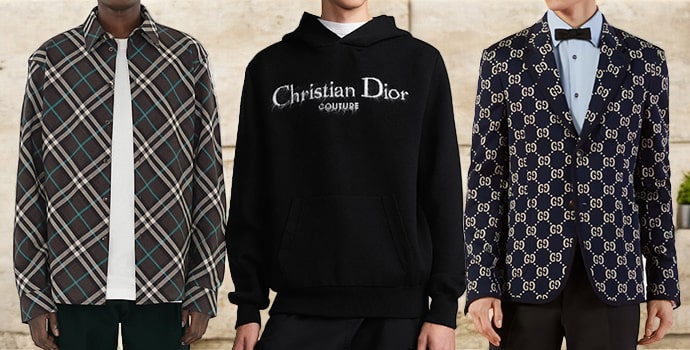What Makes Branded Clothing Ideal for Sensitive Skin?
What Makes Branded Clothing Ideal for Sensitive Skin?
Blog Article
The Significance of Sustainable Clothing: Just How It Impacts the Setting and Your Storage room
Sustainable clothing is significantly identified for its important role in minimizing the ecological impact of the rapid fashion business. By concentrating on eco-friendly products and honest production techniques, it resolves pressing eco-friendly concerns. This change not only benefits the planet yet additionally influences customer options, resulting in a much more thoughtful technique to wardrobe administration. Comprehending these characteristics elevates important inquiries about style's future and personal responsibility fit it.
The Environmental Footprint of Fast Fashion

Benefits of Sustainable Products
Lasting products offer significant benefits, specifically via eco-friendly material selections that lessen ecological damage. These materials likewise show toughness and long life, minimizing the requirement for regular substitutes. Therefore, they add to a more sustainable fashion market and advertise liable consumer habits.
Eco-Friendly Fabric Options
While the apparel industry has long been related to quick patterns and environmental harm, the increase of green material selections provides a transformative chance. Lasting products such as natural cotton, hemp, and Tencel have actually acquired popularity as a result of their reduced eco-friendly influence. These textiles are frequently created without harmful pesticides and need much less water, reducing their carbon impact - Branded Clothing. Furthermore, many environmentally friendly fabrics are biodegradable, contributing to a round economic climate by decreasing waste. Choosing lasting materials not just sustains eco responsible techniques but additionally advertises healthier environments. As customers come to be a lot more familiar with their acquiring power, the demand for environmentally friendly materials encourages brand names to introduce and adopt even more lasting production approaches, eventually benefiting the planet and future generations
Longevity and Durability Benefits
Several customers are increasingly identifying the longevity and longevity benefits of lasting products in their clothes options. Unlike standard materials, sustainable products such as organic cotton, hemp, and recycled polyester are engineered to withstand damage, causing garments that last longer. This lowered regularity of substitute not only conserves consumers cash in time but also reduces waste created by fast style. In enhancement, sustainable apparel often employs eco-friendly production approaches that enhance textile strength, adding to a decrease in the total carbon impact. By spending in durable clothes, consumers can grow an extra lasting wardrobe while enjoying top notch pieces that maintain their visual and capability gradually. Durability and long life stand as essential advantages of picking sustainable materials.
Reducing Waste Through Lasting Practices
Reducing waste in the garment industry can be attained through cutting-edge techniques such as upcycling and repurposing materials. Additionally, taking on minimal wardrobe techniques encourages consumers to prioritize high quality over quantity, eventually decreasing apparel intake. With each other, these techniques add substantially to a more lasting garments version.
Upcycling and Repurposing Products
Upcycling and repurposing materials have actually become ingenious methods in the fashion business, transforming discarded fabrics into useful new items. This strategy not only minimizes waste but additionally encourages creativity and individuality in clothing design. By taking old garments and products, designers can create unique pieces that show personal style while minimizing the need for brand-new resources. In addition, upcycling typically calls for much less energy and water compared to typical production processes, substantially reducing the ecological impact of fashion. As consumers end up being much more familiar with sustainability, the appeal of upcycled apparel remains to increase, advertising a round economic situation. Eventually, these methods contribute to a more sustainable future, where style focuses on ecological health and wellness over fast manufacturing and consumption.

Minimal Wardrobe Methods
As individuals increasingly look for to lessen their environmental impact, adopting minimalist closet approaches has obtained grip as a reliable approach to lasting style. These methods emphasize high quality over quantity, encouraging consumers to curate a smaller collection of flexible, long lasting apparel. By concentrating on ageless items that can be mixed and matched, people can decrease the frequency of purchases and ultimately decrease waste.Additionally, minimalism advertises conscious intake, prompting consumers to reflect on the moral and ecological effects of their choices. This technique not just fosters an extra lasting way of life yet likewise simplifies daily decision-making concerning clothes. As individuals welcome minimalist principles, they add to a style society that values sustainability and responsible consumerism, ultimately causing a much more eco-conscious society.
The Function of Moral Labor in Sustainable Style
While numerous consumers are increasingly aware of the environmental effects of their clothes options, the relevance of ethical labor methods in sustainable style can not be overlooked. Honest labor includes reasonable incomes, risk-free working problems, and regard for workers' rights, developing the foundation of accountable fashion production. Brands that focus on ethical labor not just boost areas however additionally set a standard for accountability in the industry.Moreover, the assimilation of honest techniques cultivates openness, making it possible for consumers to make informed selections about their acquisitions. This method contrasts dramatically with rapid fashion's unscrupulous labor versions, Branded Clothing which commonly focus on earnings over individuals. By sustaining business committed to ethical labor, customers add to a system that values human self-respect alongside ecological sustainability. As a result, honest labor is not just an add-on; it is vital to the more comprehensive goal of sustainable style, making sure that the quest for eco-friendliness does not come with the cost of human civil liberties.
The Impact of Sustainable Clothes on Carbon Emissions
Sustainable garments has the possible to significantly decrease carbon emissions connected with the fashion business. Traditional garment production adds especially to greenhouse gas emissions, mostly due to energy-intensive production procedures and the usage of non-renewable resources. In comparison, lasting fashion focuses on environment-friendly materials, such as organic cotton or recycled fibers, which frequently require much less power to produce.Moreover, lasting brands tend to take on more effective production techniques, decreasing waste and reducing overall emissions. By prioritizing durability and classic style, sustainable apparel urges consumers to purchase much less frequently, further minimizing the carbon impact connected with overconsumption.Additionally, numerous lasting brands are devoted to openness in their supply chains, making it possible for consumers to make informed choices that line up with their values. Ultimately, shifting towards lasting clothes can bring about a significant reduction in carbon exhausts, adding to a healthier planet and a more lasting future for the garment industry.
Sustaining Regional Economic Situations With Lasting Options
The change toward sustainable clothing not only addresses ecological worries but also significantly benefits local economic situations. By picking lasting fashion, customers typically sustain regional craftsmens and local business, boosting neighborhood resilience. These ventures normally run on a smaller sized range, focusing on workmanship and moral techniques over mass production.Investing in locally made sustainable garments promotes job development and boosts economic growth within communities. As customers become extra familiar with the environmental effect of their acquisitions, they significantly seek items that reflect their worths. This need urges regional manufacturers click reference to adopt lasting practices, adding to a circular economy.Moreover, supporting neighborhood organizations decreases transportation exhausts, straightening with eco-conscious customer actions. The interconnectedness of lasting apparel and local economic situations emphasizes the important role that private selections play in promoting both environmental and financial health. By fostering these neighborhood connections, communities can flourish while likewise working towards a more sustainable future.
Changing Your Wardrobe: Tips for a Sustainable Closet
As people look for to minimize their environmental effect, changing a storage room right into a lasting wardrobe comes to be a vital action. One efficient strategy is to evaluate existing garments, maintaining only things that are used frequently which line up with sustainability goals. Focusing on quality over quantity is vital; buying resilient pieces from environment-friendly brand names can significantly decrease waste.Additionally, including used things can rejuvenate a wardrobe while lessening environmental damages. Organizing garments swaps with buddies or contributing extra items can even more promote sustainability.When shopping, individuals must look for products that are organic, recycled, or naturally degradable, and stay clear of rapid fashion stores - Branded Clothing. Lastly, practicing mindful consumption by attentively thinking about each purchase can add to an extra sustainable way of living. By implementing these tips, one can develop a closet that shows personal design while sustaining ecological stewardship
Regularly Asked Concerns
How Can I Recognize Lasting Clothing Brands?
To determine lasting clothes brands, one ought to look into materials made use of, examine for accreditations like Fair Profession, and check out the brand's transparency about their manufacturing processes, labor practices, and environmental influence, ensuring honest and environment-friendly methods are focused on.
What Are the Costs Related To Lasting Fashion?
The costs related to sustainable fashion can differ significantly. Higher manufacturing expenses, moral sourcing, and environment-friendly products typically bring about raised list prices, which may deter some consumers while interesting ecologically aware shoppers.
Can Lasting Clothes Be Fashionable and stylish?
Lasting clothing can indeed be trendy and fashionable. Designers significantly prioritize innovative products and ethical manufacturing methods, proving that style and sustainability can exist together. Consumers currently have varied alternatives that mix aesthetic appeals with ecological awareness.
Exactly How Does Washing Clothes Affect Their Sustainability?
Cleaning clothes considerably effects sustainability by consuming water and power, adding to contamination, and creating microplastic release. Regular washing can degrade fabrics, shortening their life-span and boosting the need for replacements, inevitably intensifying environmental issues.
What Is the Lifespan of Lasting Garments Contrasted to Rapid Style?
The life-span of sustainable garments generally goes beyond that of quick fashion things, frequently lasting a number of years because of quality materials and workmanship. In comparison, fast style garments may deteriorate quickly, requiring more regular replacements. Sustainable clothes is progressively identified for its important duty in decreasing the environmental effect of the quick style industry. While lots of customers are increasingly aware of the environmental repercussions of their garments options, the significance of honest labor methods in sustainable style can not be forgotten. Branded Clothing. Sustainable clothing has the potential to greatly minimize carbon discharges associated with the fashion industry. In contrast, lasting style focuses on eco-friendly materials, such as natural cotton or recycled fibers, which often require less power to produce.Moreover, lasting brands have a tendency to adopt much more effective manufacturing techniques, decreasing waste and reducing overall discharges. By prioritizing longevity and ageless layout, lasting apparel urges consumers to buy much less regularly, further reducing the carbon footprint navigate here associated with overconsumption.Additionally, lots of sustainable brands are dedicated to transparency in their supply chains, enabling customers to make enlightened options that straighten with their values
Report this page